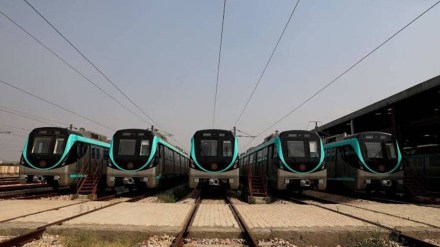Noida has witnessed remarkable growth in recent years. Central to this expansion is the Noida Metro, which has been a pivotal infrastructural asset in facilitating connectivity and easing the burden of traffic congestion. Among its key corridors, the Aqua Line stands out as a symbol of progress and development. As the Noida Metro embarks on a mega expansion plan, it’s imperative to delve into the evolution of the Aqua Line and its significance in shaping the region’s transportation landscape.
The Aqua Line, spanning over 29 kilometers and connecting Noida and Greater Noida, was inaugurated in January 2019. Its inception marked a significant milestone in the region’s transportation infrastructure, offering a swift and efficient mode of commuting for residents and commuters alike. The line boasts 21 stations, strategically positioned to cater to key residential, commercial, and institutional hubs.
One of the Aqua Line’s distinguishing features is its seamless integration with other modes of transport, including buses and shared mobility services. This multimodal connectivity enhances its accessibility and encourages more people to opt for public transportation, thereby reducing reliance on private vehicles and mitigating environmental impact.
The Noida Metro Rail Corporation (NMRC) has taken a significant step towards extending the Aqua Line corridor to Greater Noida West, approving a revised Detailed Project Report (DPR).
This extension project will encompass 11 stations, stretching from Sector 51 in Noida to Knowledge Park V in Greater Noida. The approval of the DPR, which was modified slightly to ensure seamless connectivity, marks a crucial milestone. The Delhi Metro Rail Corporation (DMRC) was tasked with revising the report.
Spurred economic growth
The Aqua Line has not only facilitated easier commutes but has also spurred economic growth along its corridor. The development of commercial and residential projects near its stations has witnessed a surge, driven by the convenience and accessibility offered by the metro. This has, in turn, led to increased property values and stimulated local businesses, thereby contributing to the overall socio-economic development of the region.
The success of the Aqua Line has not been without its challenges. Operational efficiency, maintenance, and last-mile connectivity have been areas of concern that require continuous attention and improvement. Ensuring reliability and safety remains paramount to sustain public trust and encourage greater ridership.
Recognising the Aqua Line’s pivotal role in the region’s development, authorities have initiated ambitious expansion plans to further enhance its reach and capacity. The proposed expansion includes extending the line to new corridors and integrating it with existing and upcoming metro networks in the National Capital Region (NCR). This expansion aims to cater to the burgeoning population and address the increasing demand for efficient transportation solutions.
Streamline travel for commuters in Noida and Greater Noida
Anticipated to alleviate the transportation woes of residents in Greater Noida West, who have long clamored for better public transit options, this project aims to streamline travel for commuters in Noida and Greater Noida. It is expected to ease traffic congestion along Vikas Marg and the Noida-Greater Noida Link Road.
The Noida Sector 61 station will serve as a vital interchange hub between the Aqua Line and DMRC’s Blue Line. The DPR’s approval will now be sought from the Uttar Pradesh Government and the Central authorities.
Moreover, the expansion plans underscore a broader vision of promoting sustainable urban development and reducing carbon footprint. By encouraging modal shift towards public transportation, the Noida Metro not only alleviates traffic congestion but also contributes to air quality improvement and environmental conservation efforts.
Cost
According to the latest report, the project’s total completion cost is estimated at Rs 2,991.60 crore, spanning a distance of 17.43 km.
The successful evolution and expansion of the Aqua Line hinge upon collaborative efforts between various stakeholders, including government agencies, urban planners, developers, and the community. Public participation and feedback play a crucial role in shaping future projects and ensuring that they align with the needs and aspirations of the people.
The Aqua Line of the Noida Metro stands as a testament to the power of strategic infrastructure development in fostering urban growth and connectivity. Its evolution from inception to expansion reflects a commitment to enhancing the quality of life for residents while promoting sustainable and inclusive development. As the metro network continues to evolve, it holds the promise of transforming Noida and Greater Noida into vibrant, accessible, and environmentally conscious urban centers.
Few limitations
The earlier Detailed Project Report had outlined a foot overbridge to connect Sector 51 (Aqua Line) and Sector 52 (Blue Line) stations. However, NMRC identified limitations in this plan, citing the substantial distance of 430 meters between the stations. It argued that even with travellators, encouraging commuters to utilize the bridge would be challenging. The proposed stations include Noida Sector 61, Noida Sector 70, Noida Sector 122, Noida Sector 123, Greater Noida Sector 4, EcoTech 12, Greater Noida Sector 2, Greater Noida Sector 3, Greater Noida Sector 10, Greater Noida Sector 12, and Greater Noida Knowledge Park V.
Benefits of the Aqua line project
Residents from Noida, Greater Noida West, and Greater Noida stand to gain significant advantages from the project through improved connectivity along Vikas Marg and the Noida-Greater Noida Link Road. Extending the Aqua Line corridor will not only shorten travel durations but also alleviate congestion on these thoroughfares.
